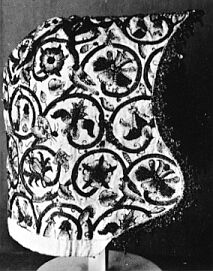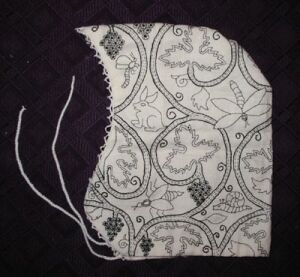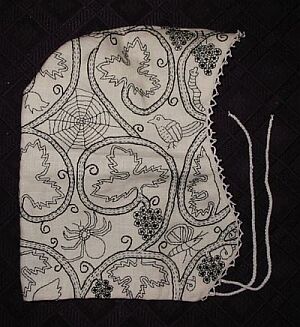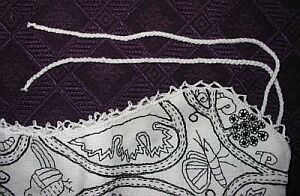|

|
Getting curious about
a subject can be a dangerous thing. I got curious about
blackwork over 2 years ago, started a handkerchief, got only
5 cm along, then had an idea of an Elizabethan blackwork
coif. I found pictures of some extent coifs, (left: Woman's coif late 16th
century at Victoria& Albert museum) and a blackwork sleeve from Janet Arnold's
"Queen Elizabeth's Wardrobe Unlock'd" (fig 274) dated 1600.
Both were linen with black silk blackwork. The coif had
bobbin lace around the face.
Then came the research (see below
for bibliography). First I had to learn to blackwork. With
the help of my Pelican, Mistress Aislinn, I found books on
blackwork. I also raided the internet and found some
wonderful websites on Elizabethan blackwork and how to make
coifs.
|
Materials:
Most of the research that I
came across showed the coif made of linen, so I bought 100% linen
from Lincraft. I couldn't afford silk
thread at the time, and had some black DMC cotton embroidery thread
so decided to use this. I used interfacing to draw my pattern and
stitched over it, then removed the paper as the pattern was
completed. Very time-consuming, but as I figure, it was one way the
pattern was copied in period. The bobbin lace and fingerbraid cord
were both made from cotton. More on this later, as this was thought
of much later.
Design:
I based my designs on the
swirling vine of the above coif, but used the details from the sleeve
in Janet Arnold. I loved the little bugs and critters. My favourite
was the spider and web. I used the common shape of the coif, with a
pointed front at the forehead.
Execution:
|
|
The pattern was attatched to a
piece of rectangular linen. From the research I had done and
some of the extent pictures I found, it seemed that the coif
was stitched onto a rectangular shape and then cut out
later. This also made it much easier to embroider on a hoop.
The entire pattern is seen to the left. I used holbein
running stitch (I didn't know any better, thinking all
blackwork must be done this way!) and chain stitch for the
vines. This when I discovered that this stitch takes
forever. I have now learnt that freestyle patterns were
often done in split stitch. So much quicker!
|
|

|

|
|
Finally, I had finished the
blackwork (it took a year and went around the world with me
- back then you could take needles in the cabin with you).
Then not knowing how to finish it off properly, it
sat...
Then Mistress Miriam Galbraith came
to Innilgard for our A&S collegium and I learned both
bobbin lace basics and fingerbraiding. My inspiration had
come to finish that coif.
|

|
I used cotton thread and hand sewed
the seam, used cotton to line the coif, made a channel, on
the inside of the coif, for the newly made white cotton
fingerbraided cord, and made cotton bobbin lace for around
the face. Finally, it was finished!
Now, I just have to finish the
appropriate garb to wear with it!
BIBLIOGRAPHY:
Arnold, Janet: Queen Elizabeths Wardrobe
Unlock'd , WS Maney &
Sons, London, 1988
Snook, Barbara, English Embroidery, Bell & Hyman, London, 1974
Websites:
"Embroidering a Blackwork Coif "by
Mistress Dorren of Ashwell: www.rezonate,com/gpearl/blwork.htm
"Lady Roxanne's Blackwork Article"
: www.geocities.com/Athens/Crete/1581/art1.htm
"Making an Elizabethan Coif" :
http://costume.dm.net/headwear/coifmake/html